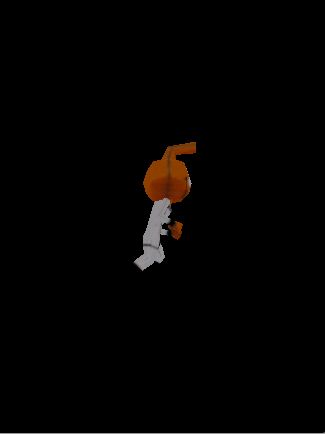android 3D 游戏实现之人物行走(MD2)
如果充分理解了HelloWorld(见android 3D 游戏实现之First step),了解了一些JPCT-AE游戏框架的机制,
那么,这个示例可以是进阶篇了,其实用JPCT-AE加载3DS,MD2文件都很简单了,主要是掌握一些基本的操作,
今天我先把怎么实现加载MD2文件的代码附上,明天我再传上如果实现载入3DS及3DS KeyFrame动画的代码附上。
此程序所需的纹理贴图及MD2文件请从http://download.csdn.net/user/Simdanfeg处下载
下面附上源程序(呵呵,很Cool^_^)
(1)Activity源码
package sim.feel;
import java.io.IOException;
import java.io.InputStream;
import android.app.Activity;
import android.content.res.AssetManager;
import android.content.res.Resources;
import android.graphics.Bitmap;
import android.graphics.BitmapFactory;
import android.opengl.GLSurfaceView;
import android.os.Bundle;
public class LoadM extends Activity {
private GLSurfaceView glView;
private MyRenderer mr;
@Override
public void onCreate(Bundle savedInstanceState) {
super.onCreate(savedInstanceState);
// 加载图片
LoadImage.loadi(getResources());
// 加载文件
new LoadAssets(getResources());
glView = new GLSurfaceView(this);
mr = new MyRenderer();
glView.setRenderer(mr);
setContentView(glView);
}
}
// 载入纹理图片
class LoadImage {
public static Bitmap bitmap;
public static void loadi(Resources res) {
bitmap = BitmapFactory.decodeResource(res, R.drawable.disco);
}
}
// 载入Assets文件夹下的文件
class LoadAssets {
public static Resources res;
public LoadAssets(Resources resources) {
res = resources;
}
public static InputStream loadf(String fileName) {
AssetManager am = LoadAssets.res.getAssets();
try {
return am.open(fileName, AssetManager.ACCESS_UNKNOWN);
} catch (IOException e) {
return null;
}
}
}
(2)MyRenderer类代码
package sim.feel;
import javax.microedition.khronos.egl.EGLConfig;
import javax.microedition.khronos.opengles.GL10;
import android.opengl.GLSurfaceView.Renderer;
import com.threed.jpct.FrameBuffer;
import com.threed.jpct.Loader;
import com.threed.jpct.Object3D;
import com.threed.jpct.RGBColor;
import com.threed.jpct.Texture;
import com.threed.jpct.TextureManager;
import com.threed.jpct.World;
public class MyRenderer implements Renderer {
// 纹理数组
private String[] textures = { "disco" };
// scale
private float thingScale = 0.8f;
// world对象
private World world;
// FrameBuffer对象
private FrameBuffer fb;
// Object3D
private Object3D snork;
// 行走动画
private int an = 2;
private float ind = 0;
/**
* 绘制到屏幕上
*/
public void onDrawFrame(GL10 gl) {
doAnim();
// 以蓝色清除整个屏幕
fb.clear(RGBColor.BLACK);
world.renderScene(fb);
world.draw(fb);
fb.display();
}
public void onSurfaceChanged(GL10 gl, int width, int height) {
if (fb != null) {
fb = null;
}
fb = new FrameBuffer(gl, width, height);
}
public void onSurfaceCreated(GL10 gl, EGLConfig arg1) {
world = new World();
world.setAmbientLight(150, 150, 150);
// 将所有纹理添加到所定义的纹理数组中,此程序只有一个,所以为txtures[0]
for (int i = 0; i < textures.length; i++) {
TextureManager.getInstance().addTexture(textures[i],
new Texture(LoadImage.bitmap));
}
// 从assets文件夹中读取snork.md2文件
snork = loadModel("snork.md2", thingScale);
// 旋转snork对象到"适当位置"
snork.translate(0, -25, -50);
// 给snork对象添加名为disco的纹理贴图
snork.setTexture(textures[0]);
// 释放部分资源
snork.strip();
// 编译
snork.build();
// 将snork添加到World对象中
world.addObject(snork);
world.getCamera().setPosition(0, 0, -100);
world.getCamera().lookAt(snork.getTransformedCenter());
}
// 载入模型
private Object3D loadModel(String filename, float scale) {
Object3D model = Loader.loadMD2(LoadAssets.loadf(filename), scale);
return model;
}
/**
* 实现MD2人物行走的关键代码
*/
public void doAnim() {
//每一帧加0.018f
ind += 0.018f;
if (ind > 1f) {
ind -= 1f;
}
// 关于此处的两个变量,ind的值为0-1(jpct-ae规定),0表示第一帧,1为最后一帧;
//至于an这个变量,它的意思是sub-sequence如果在keyframe(3ds中),因为在一个
//完整的动画包含了seq和sub-sequence,所以设置为2表示执行sub-sequence的动画,
//但这里设置为2我就不太明白了,不过如果不填,效果会不自然,所以我就先暂时把它
//设置为2
snork.animate(ind, an);
}
}
运行效果:
